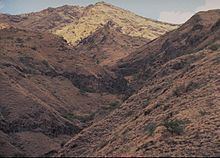 | ||
The Ethiopian xeric grasslands and shrublands ecoregion is a semi-desert strip on or near the Red Sea and the Gulf of Aden coasts in Eritrea, Ethiopia, Djibouti and Somalia. This ecoregion lies mainly between sea level and 800 meters (m) elevation. There are, however, many hills and massifs, which range up to 1300 m as well as outstanding fault-induced depressions, such as the Danakil, lying as low as 155 m below sea level. This region is extremely active tectonically, experiencing many earthquakes and intermittently active volcanoes. Rainfall is very low and yearly averages range from 100 to 200 millimeters (mm), with less rain falling closer to the coast. There are many species of interest, including the endemic Archer's lark (Heteromirafra archeri), a species of dragon tree (Dracaena ombet), and a large suite of desert ungulates, including the last viable population of African wild ass (Equus africanus somalicus).
Contents
Location and description
This ecoregion extends inland from the Red Sea and the Gulf of Oman, including the Dahlak Archipelago and other islands, stretching from the Sudanese-Eritrean border, south through Ethiopia to Djibouti and eastwards into Somalia, in the Somaliland region of the country. While it mainly lies between sea level and 800 m, there are many arid hills and massifs up to 1300 m. Higher massifs such as the Goda and Mabla in Djibouti are considered to be outliers of the Ethiopian Montane Forest ecoregion. There are also fault-induced depressions, such as the Danakil Depression and Lac Assal, lying as much as 160 m below sea level. Elevation generally increases westward towards the Ethiopian and Eritrean highlands. The region is extremely active tectonically, and it experiences many earthquakes associated with the continuing enlargement of the Rift Valley. Volcanoes in the ecoregion are also intermittently active. Basement rocks are composed mainly of Tertiary lava flows, although there are also Quaternary basinal deposits at the northern end and pre-Cretaceous basinal deposits on the northern coast of Somalia. Soils developed over the lava deposits are mainly lithosols, while regosols are predominant on the Quaternary and pre-Cretaceous basinal deposits. There are very few permanent watercourses. The most notable is the Awash River of Ethiopia that terminates in a series of lakes near the border with Djibouti.
Climate
The climate is very hot and dry. Mean annual rainfall varies from less than 100 mm close to the coast to around 200 mm further inland. Mean minimum temperatures range from 21° to 24°C, and mean maximum temperature is around 30°C. Most of the people have to build their houses with clay to keep the hot outside and the cold outside.
Flora
The plant life of the region needs more study, which has been hampered by long-term political strife in the region. Endemic flora includes a dragon tree (Dracaena ombet). Due largely to political instability in the region over the last 30 years, many elements of the fauna and flora remain poorly known. As a suggestion of floral richness, an estimated 825 to 950 species have been observed in Djibouti, although many of these have been found only in the small outlying patches of the Ethiopian montane forest. These outliers are part of the Day Forests and Mabla Massifs above 1,100 m in Djibouti.
Fauna
Mammals found here include the last Somali Wild Ass (Equus africanus somalicus) to be found in the wild, on the Buri Peninsula of Eritrea. Other grazing animals include Beira, Dorcas gazelle, Soemmerring's Gazelle, gerenuk and the Beisa oryx. The only purely endemic mammal is a gerbil Gerbillus acticola. There are a number of dry habitat reptiles including the endemic geckos, Arnold's leaf-toed gecko (Hemidactylus arnoldi) and the Somali Northern Sand Gecko (Tropiocolotes tripolitanus somalicus). Birds include the endemic Archer's lark (Heteromirafra archeri).
Threats and preservation
Human population density is typically less than ten persons per square kilometer (km2). In some areas, there is less than one person per km2. The dominant ethnic groups are the nomadic pastoralist Afars and a Somali clan, the Issas. Human density, however, does not account for grazing animals. The conservation status of this ecoregion is not good, with few protected areas and lack of enforcement in existing ones. Habitats however have been degraded, mainly by grazing of livestock as well as cutting of trees for firewood and clearing of land for planting. The only protected area is the Mille-Serdo Wild Ass Reserve in Ethiopia although protection is planned for the Buri Peninsula and the Danakil Depression in Eritrea. Urban areas in the region include the ports of Massawa in Eritrea, Djibouti city, and Berbera in Somalia. Smaller towns include the former Afar Region capital of Asaita in Ethiopia and smaller ports along the coast such as Tadjoura in Djibouti and Zeila in Somalia. Tourism in the region includes diving in the Dahlak islands.
